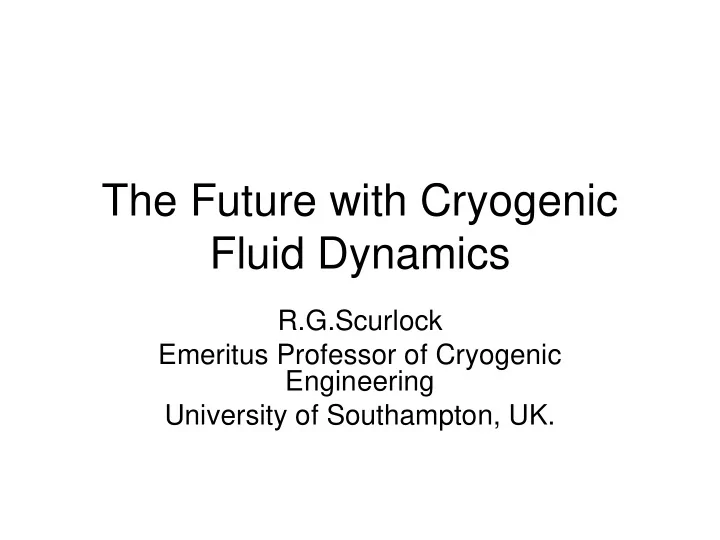

The Future with Cryogenic Fluid Dynamics R.G.Scurlock Emeritus Professor of Cryogenic Engineering University of Southampton, UK.
The Future with Cryogenic Fluid Dynamics • Contents • Definitions • Natural convection in cryogenic systems • Applications of CryoFD • Some anecdotes on global uses • Conclusions
Contributors to Development of CryoFD at IoC,Southampton • Staff and RFs: C.Beduz, T.Haruyama, L.Haseler,, K.Kellner, M.Islam, P.McDonald, I.Morton, G.Rao, D.Utton, J.Watson,Y.Yang. • PhD Students: O.Abreu, A.Acton, T.Agbabi, S.Ashworth, M.Atkinson-Barr, A.Ball, G.Beresford, J.Boardman, A.DeSouza, R.Igra, P.Lynam, A.Mustafa, A.Pasek, W.Proctor, R.Rebiai, D.Richards, O.San Roman, J.Shi, A.Tchikou, G.Thornton, M.Wray, M.Wu, Y.Wu, S.Yun.
Cryogenic temperature range • 1884 K.Onnes. Cryogenic Lab at Leiden. • 1935 M.Ruhemann. Set 120K as limit. • 1971 N.Kurti. Reset 120K, for Cryology. • 1992 R.Scurlock. Proposed 273K.0ºC. • 2011 R.Scurlock. Proposed 250K. -23ºC.
Open loop liquid convection circulation
Surface evaporation mass flux vs. bulk superheat Δ T
Morphology and temperature profile across evaporating surface sub-layer
Limits of surface evaporation mass flux vs. Δ T
Distinction between A and B heat inflows
Sensible heat of vapour Δ H (from NBP to 300K) and Latent heat of evaporation λ • λ kJ/kg Δ H kJ/kg Δ H/ λ • Helium 4 20.7 1564 75.5 • Hydrogen 445 3511 7.9 • Neon 85.7 283 3.3 • Nitrogen 199 234 1.2 • Oxygen 212 193 0.9 • Methane 510 404 0.8
Vapour boundary layer flow and recirculation
Vapour cooled shields. (a) LHe dewar (b) LNG storage tank
Vapour cooled shields. Variation of helium boil-off with position
Design diagram for minimum helium boil-off
Laser Doppler Velocity diagram of liquid recirculation
Liquid recirculation in storage tank
Vapour recirculation ratio of Mass flow / Boil-off mass flow
Multi-shielding for LHe containment
Typical vapour and liquid composition (T,x) curves during equilibrium (free boiling) and non- equilibrium surface evaporation
Stratification in LNG leading to Rollover
Differences in vapour flash between propane- butane and butane-propane mixing
Log S vs. 1/T solubility curves
Improvement in helium cryostat performance • Date Duration %age boil-off/ day • 1955 6h 400 • 1965 100h 24 • 1975 100 days 1 • 1985 300 days 0.3 • 1995 1000 days 0.1
Examples of CryoFD applications • Tilted LHe cooled amplifier on Goonhilly radio aerial for first trans-Atlantic TV trials via Telstar satellite in 1962. • Doubling cooling power of cryocooler/condenser with no change in compressor, with Cryomech. • 15 kA current leads with 1W heat leak at 4.2K for LHC. • All the year round LHe at the South Pole from 2001. • 100 fold increase in reboiler/condenser heat transfer rates for Air Separation Units. • Safety of pressurised LNG as road transport fuel. • Cryogenic liquids for high density energy storage between renewable sources and AC power grid.
• My Pictures\img001.jpg
• My Pictures\img022.jpg
Conclusions • CryoFD for development of “Green Cryogenics” with minimum energy and liquid loss rates; also use of cryogenic fluids for energy storage between renewable source and electric grid. • Effective use of sensible heat of cold vapour from NBPs up to 300K with no visible frost. • Use the enhanced heat transfer rates across horizontal isothermal planes; also in vertical flows such as liquid and vapour boundary layer flows, and falling liquid film flows;. • Much research needed to establish correlations for computer modelling from today’s concepts.
Recommend
More recommend